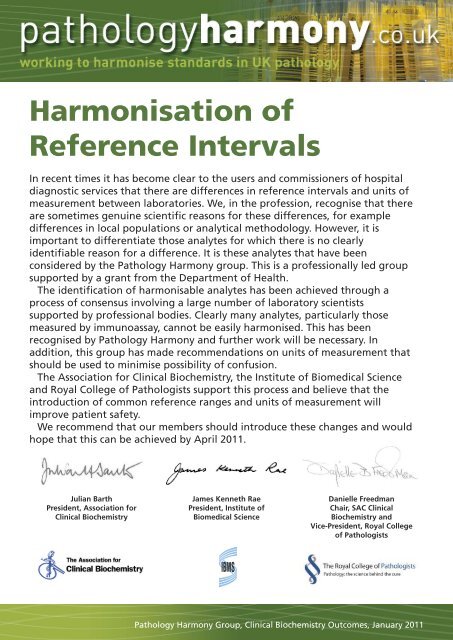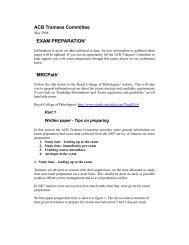Harmonisation of Reference Intervals - The Association for Clinical ...
Harmonisation of Reference Intervals - The Association for Clinical ...
Harmonisation of Reference Intervals - The Association for Clinical ...
You also want an ePaper? Increase the reach of your titles
YUMPU automatically turns print PDFs into web optimized ePapers that Google loves.
<strong>Harmonisation</strong> <strong>of</strong><br />
<strong>Reference</strong> <strong>Intervals</strong><br />
In recent times it has become clear to the users and commissioners <strong>of</strong> hospital<br />
diagnostic services that there are differences in reference intervals and units <strong>of</strong><br />
measurement between laboratories. We, in the pr<strong>of</strong>ession, recognise that there<br />
are sometimes genuine scientific reasons <strong>for</strong> these differences, <strong>for</strong> example<br />
differences in local populations or analytical methodology. However, it is<br />
important to differentiate those analytes <strong>for</strong> which there is no clearly<br />
identifiable reason <strong>for</strong> a difference. It is these analytes that have been<br />
considered by the Pathology Harmony group. This is a pr<strong>of</strong>essionally led group<br />
supported by a grant from the Department <strong>of</strong> Health.<br />
<strong>The</strong> identification <strong>of</strong> harmonisable analytes has been achieved through a<br />
process <strong>of</strong> consensus involving a large number <strong>of</strong> laboratory scientists<br />
supported by pr<strong>of</strong>essional bodies. Clearly many analytes, particularly those<br />
measured by immunoassay, cannot be easily harmonised. This has been<br />
recognised by Pathology Harmony and further work will be necessary. In<br />
addition, this group has made recommendations on units <strong>of</strong> measurement that<br />
should be used to minimise possibility <strong>of</strong> confusion.<br />
<strong>The</strong> <strong>Association</strong> <strong>for</strong> <strong>Clinical</strong> Biochemistry, the Institute <strong>of</strong> Biomedical Science<br />
and Royal College <strong>of</strong> Pathologists support this process and believe that the<br />
introduction <strong>of</strong> common reference ranges and units <strong>of</strong> measurement will<br />
improve patient safety.<br />
We recommend that our members should introduce these changes and would<br />
hope that this can be achieved by April 2011.<br />
Julian Barth<br />
President, <strong>Association</strong> <strong>for</strong><br />
<strong>Clinical</strong> Biochemistry<br />
James Kenneth Rae<br />
President, Institute <strong>of</strong><br />
Biomedical Science<br />
Danielle Freedman<br />
Chair, SAC <strong>Clinical</strong><br />
Biochemistry and<br />
Vice-President, Royal College<br />
<strong>of</strong> Pathologists<br />
Pathology Harmony Group, <strong>Clinical</strong> Biochemistry Outcomes, January 2011
Agreed Adult <strong>Clinical</strong> Biochemistry <strong>Reference</strong> <strong>Intervals</strong><br />
Test Name Units Range low Range high Comments<br />
Sodium mmol/L 133 146<br />
Potassium mmol/L 3.5 5.3<br />
Urea mmol/L 2.5 7.8<br />
Chloride mmol/L 95 108<br />
Bicarbonate mmol/L 22 29<br />
Phosphate mmol/L 0.8 1.5<br />
Magnesium mmol/L 0.7 1.0<br />
Albumin g/L 35 50<br />
Total Protein g/L 60 80<br />
Osmolality mmol/kg 275 295<br />
Alkaline Phosphatase (ALP) U/L 30 130 IFCC candidate method p-NPP using AMP buffer<br />
Creatine Kinase (CK) U/L 40 320 (M) Ranges are <strong>for</strong> white Caucasian only;<br />
25 200 (F) other ethnic groups may have higher values<br />
Bilirubin (total) µmol/L
Agreed Paediatric <strong>Clinical</strong> Biochemistry <strong>Reference</strong> <strong>Intervals</strong><br />
Test Name Age Units Range low Range high Comments<br />
Sodium No age-related differences mmol/L 133 146<br />
Plasma Potassium Neonate mmol/L 3.4 6.0<br />
Infant mmol/L 3.5 5.7<br />
1-16 yrs mmol/L 3.5 5.0<br />
Urea Neonate mmol/L 0.8 5.5<br />
Infant mmol/L 1.0 5.5<br />
1-16 yrs mmol/L 2.5 6.5<br />
Magnesium Neonate mmol/L 0.6 1.0<br />
Infant - 16 yrs mmol/L 0.7 1.0<br />
Plasma lactate No age-related differences mmol/L 0.6 2.5 Enzymatic method only<br />
Bilirubin (total) 14 days - 16 yrs µmol/L




